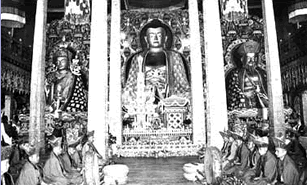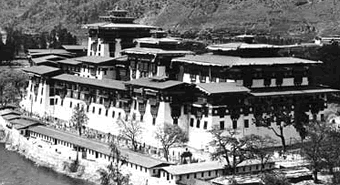 |
Bhutan's Culture - Dzongs |
|
 |
Bhutan Information |
|
|
 |
The
home ministry was given the overall responsibility with the Tenso Lapon,
Dasho Wangchuk, as site supervisor. Tenso Lapon Dasho Wangchuk is the recipient of the Druk Thuksey for his outstanding contributions
in the renovation of the Punakha Dzong and restoration of lhakhangs and
monasteries.
The five
lhakhangs above the Kuenrey were all re-built and new sacred images
installed: Neten Chudrung, Goengkhang, Lhamo, Rigsum Gompo, and
Phurpai Lhakhang. In accordance to prophesy a 10-foot Guru Dorji
Droley image was installed in the Droley Lhakhang facing the
confluence of the Phochu and Mochu rivers.
The Tsen
Chhorten was reconstructed as a two-storey building and the Je Khenpo's
residence expanded into a four-room apartment with a choekhang. All the
woodwork of massive beams, joists, pillars, floors, doors and windows -
in the five floors of the Utse was changed, with timber brought
in from different dzongkhags. So were the wooden structures on the roof
of the dukhang. New kitchen and restrooms for the monks were constructed
outside the dzong to reduce the risk of fire.
In 1994 a catastrophic flood damaged the Dzongchung although the Jhou
(Buddha image) was miraculously saved. Originally built in 1374 by the great sage Dupthop Ngagi Rinchhen, the dzongchung was restored in 1996 and consecrated by His Holiness, Geshe Gueden Rinchhen, the 69th Je
Khenpo. Besides enlarging the plinth area to 1,500 square feet from
the previous 590 square feet a large retaining wall, 25 to 35 feet in height,
was constructed around the Dzongchhung, using stone masonry and
cement mortar.
More
than 200 new images crafted for the dzong represent some of the finest
masterpieces available in the country. The Shakyamuni Buddha, Guru
Rinpoche, and Zhabdrung Ngawang Namgyal in the Kuenrey,
the life-size gilded images of Mahakala and Pelden Lhamo in the goenkhang,
and dozens of larger-than-life images are unique works of art achieved
through meditative focus and concentration.
The Yeshey
Semba (essence of primordial wisdom deity) for the numerous lhakhangs,
chhortens, altars, and images in the dzong are invaluable treasures
offered by His Majesty the King and the royal family, lams and trulkus,
and devotees from all parts of the country.
Punakha
Dzong was the seat of Zhabdrung Ngawang Namgyal's rule during which
he unified the country, protected it from external invasion, strengthened
the teachings of the Dharma, and established the tenets of the Bhutanese
identity. On December 17, 1907,
it was in this dzong that the Dratshang, Ponlops and Dzongpons, on behalf
of the Bhutanese population, put their seals on the historic genja and
unanimously elected Gongsar Ugyen Wangchuck as the first hereditary monarch
of Bhutan.
With
the completion of the project it has been enriched in religious treasures,
in structural endurance, and in the beauty of traditional Bhutanese architecture
and artwork by the fourth Druk Gyalpo. The Dewachenpoi Phodrang is, today, the sacred impregnable monument that Guru Rinpoche prophesied
and Zhabdrung Ngawang Namgyal established.
 |
 |
| The
Dratshang performs the consecration ceremony in the Kuenrey |
The
Pungthang Dewachenpoi Phodrang |
| Information on Bhutan |
 |
|




